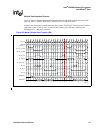
Hardware Reference Manual 171
Intel
®
IXP2800 Network Processor
Microengines
4.1.3 Datapath Registers
As shown in the block diagram in Figure 56, each Microengine contains four types of 32-bit
datapath registers:
• 256 General Purpose registers
• 512 Transfer registers
• 128 Next Neighbor registers
• 640 32-bit words of Local Memory
4.1.3.1 General-Purpose Registers (GPRs)
GPRs are used for general programming purposes. They are read and written exclusively under
program control. GPRs, when used as a source in an instruction, supply operands to the execution
datapath. When used as a destination in an instruction, they are written with the result of the
execution datapath. The specific GPRs selected are encoded in the instruction.
The GPRs are physically and logically contained in two banks, GPR A and GPR B, defined in
Table 57.
Note: The Microengine registers are defined in the IXP2400 and IXP2800 Network Processor
Programmer’s Reference Manual.
4.1.3.2 Transfer Registers
There are four types of transfer (abbreviated as Xfer) registers used for transferring data to and
from the Microengine and locations external to the Microengine (DRAMs, SRAMs, etc.).
• S_TRANSFER_IN
• S_TRANSFER_OUT
• D_TRANSFER_IN
• D_TRANSFER_OUT
Transfer_In registers, when used as a source in an instruction, supply operands to the execution
datapath. The specific register selected is either encoded in the instruction or selected indirectly
using T_Index. Transfer_In registers are written by external units based on the Push_ID input to
the Microengine.
Transfer_Out registers, when used as a destination in an instruction, are written with the result from
the execution datapath. The specific register selected is encoded in the instruction, or selected
indirectly via T_Index. Transfer_Out registers supply data to external units based on the Pull_ID
input to the Microengine.
As shown in Figure 56, the S_TRANSFER_IN and D_TRANSFER_IN registers connect to both
the S_Push and D_Push buses via a multiplexor internal to the Microengine. Additionally, the
S_TRANSFER_OUT and D_TRANSFER_OUT Transfer registers connect to both the S_Pull and
D_Pull buses. This feature enables a programmer to use the either type of transfer register
regardless of the source or destination of the transfer.


















